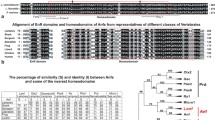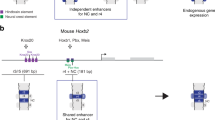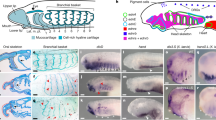Abstract
snail genes mark presumptive mesoderm across bilaterian animals. In gnathostome vertebrates, snail genes are a multimember family that are also markers of premigratory neural crest (pnc) and some postmigratory neural crest derivatives in the pharyngeal arches. Previous studies of nonvertebrate chordates indicate that they have single snail genes that retain ancestral functions in mesoderm development and perhaps in specification of a pnc-like cell population. Lampreys are the most basal extant vertebrates, with well-defined developmental morphology. Here, we identify a single snail gene from the lamprey Petromyzon marinus that is the phylogenetic outgroup of all gnathostome snail genes. This single lamprey snail gene retains ancestral snail patterning domains present in nonvertebrate chordates. Lamprey snail is also expressed in tissues that are broadly equivalent to the combined sites of expression of all three gnathostome snail paralogy groups, excepting in embryonic tissues that are unique to gnathostomes. Importantly, while snail does not appear to demarcate an early neural crest population in lampreys as it does in gnathostomes, it may be involved in later neural crest development. Together, our results indicate that significant cis-regulatory innovation occurred in a single snail gene before the vertebrate radiation, and significant subfunctionalization occurred after snail gene duplications in the gnathostome lineages.




Similar content being viewed by others
References
Carl TF, Dufton C, Hanken J, Klymkowsky MW (1999) Inhibition of neural crest migration in xenopus using antisense slug RNA. Dev Biol 213:101–115
Carver EA, Jiang R, Lan Y, Oram KF, Gridley T (2001) The mouse snail gene encodes a key regulator of the epithelial–mesenchymal transition. Mol Cell Biol 21:8184–8188
Corbo JC, Erives A, Di Gregorio A, Chang A, Levine M (1997) Dorsoventral patterning of the vertebrate neural tube is conserved in a protochordate. Development 124:2335–2344
Force A, Lynch M, Pickett FB, Amores A, Yan YL, Postlethwait J (1999) Preservation of duplicate genes by complementary, degenerative mutations. Genetics 151:1531–1545
Gans C, Northcutt RG (1983) Neural crest and the origin of vertebrates: a new head. Science 220:268–274
Hammerschmidt M, Nusslein-Volhard C (1993) The expression of a zebrafish gene homologous to drosophila snail suggests a conserved function in invertebrate and vertebrate gastrulation. Development 119:1107–1118
Isaac A, Sargent MG, Cooke J (1997) Control of vertebrate left–right asymmetry by a snail-related zinc finger gene. Science 275:1301–1304
Janvier P (1996) Early verterbates. Clarendon, Oxford
Langeland JA, Tomsa JM, Jackman WR Jr, Kimmel CB (1998) An amphioxus snail gene: expression in paraxial mesoderm and neural plate suggests a conserved role in patterning the chordate embryo. Dev Genes Evol 208:569–577
Locascio A, Manzanares M, Blanco MJ, Nieto MA (2002) Modularity and reshuffling of snail and slug expression during vertebrate evolution. Proc Natl Acad Sci USA 99:16841–16846
Mallat J, Sullivan J (1998) 28s and 18s rDNA sequences support the monophyly of lampreys and hagfishes. Molecular Biol Evol 15:1706–1718
Manzanares M, Blanco MJ, Nieto MA (2004) Snail3 orthologues in vertebrates: divergent members of the snail zinc-finger gene family. Dev Genes Evol 214:47–53
McCauley DW, Bronner-Fraser M (2003) Neural crest contributions to the lamprey head. Development 130:2317–2327
McCauley DW, Bronner-Fraser M (2006) Importance of soxe in neural crest development and the evolution of the pharynx. Nature 441:750–752
Neidert AH, Virupannavar V, Hooker G, Langeland JA (2001) Lamprey dlx genes and early vertebrate evolution. PNAS 98(4):1665–1670
Nieto MA (2002) The snail superfamily of zinc-finger transcription factors. Nat Rev Mol Cell Biol 3:155–166
Nieto MA, Bennett MF, Sargent MG, Wilkinson DG (1992) Cloning and developmental expression of sna, a murine homologue of the Drosophila snail gene. Development 116:227–237
Nieto MA, Sargent MG, Wilkinson DG, Cooke J (1994) Control of cell behavior during vertebrate development by slug, a zinc finger gene. Science 264:835–839
Ohno S (1970) Evolution by gene duplication. Springer, Heidelberg
Osorio J, Retaux S (2008) The lamprey in evolutionary studies. Dev Genes Evol 218:221–235
Ota KG, Kuraku S, Kuratani S (2007) Hagfish embryology with reference to the evolution of the neural crest. Nature 446:672–675
Sauka-Spengler T, Meulemans D, Jones M, Bronner-Fraser M (2007) Ancient evolutionary origin of the neural crest gene regulatory network. Dev Cell 13:405–420
Smith DE, Franco del Amo F, Gridley T (1992) Isolation of sna, a mouse gene homologous to the drosophila genes snail and escargot: its expression pattern suggests multiple roles during postimplantation development. Development 116:1033–1039
Stock DW, Whitt GS (1992) Evidence from 18s ribosomal RNA sequences that lampreys and hagfishes form a natural group. Science 257:87–89
Tahara Y (1988) Normal stages of development of the lamprey Lampetra reissneri (dybowski). Zool Sci 5:109–118
Thisse C, Thisse B, Schilling TF, Postlethwait JH (1993) Structure of the zebrafish snail 1 gene and its expression in wild-type, spadetail, and no tail mutant embryos. Development 119
Thisse C, Thisse B, Postlethwait JH (1995) Expression of snail2, a second member of the zebrafish snail family, in cephalic mesendoderm and presumptive neural crest of wild-type and spadetail mutant embryos. Dev Biol 172:86–99
Tomsa JM, Langeland JA (1999) Otx expression during lamprey embryogenesis provides insights into the evolution of the vertebrate head and jaw. Dev Biol 207:26–37
Trinh A, McCutchen MD, Bonner-Fraser M, Fraser SE, Bumm LA, McCauley DW (2007) Fluorescent in situ hybridization employing the conventional nbt/bcip chromogenic stain. Biotechniques 42:756–759
Wada S, Saiga H (1999) Cloning and embryonic expression of hrsna, a snail family gene of the ascidian Halocynthia roretzi: implication in the origins of mechanisms for mesoderm specification and body axis formation in chordates. Dev Growth Differ 41:9–18
Acknowledgments
We thank Roger Bergstedt and the staff of the Lake Huron Biological Station for their assistance in the rearing of lamprey embryos. This work was supported by NSF Award No. IBN-0110540 to JAL.
Author information
Authors and Affiliations
Corresponding author
Additional information
Communicated by M. Hammerschmidt
Rights and permissions
About this article
Cite this article
Rahimi, R.A., Allmond, J.J., Wagner, H. et al. Lamprey snail highlights conserved and novel patterning roles in vertebrate embryos. Dev Genes Evol 219, 31–36 (2009). https://doi.org/10.1007/s00427-008-0258-4
Received:
Accepted:
Published:
Issue Date:
DOI: https://doi.org/10.1007/s00427-008-0258-4




